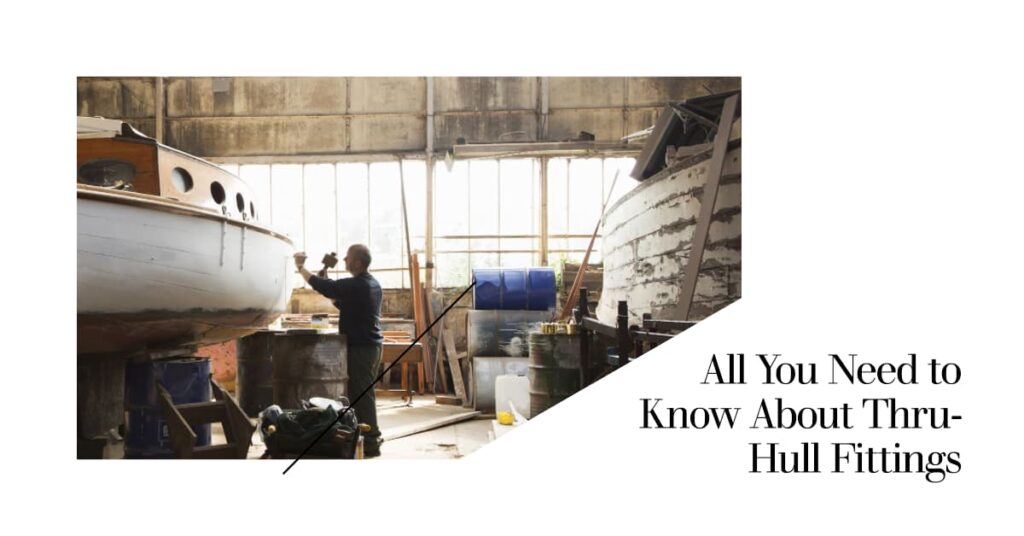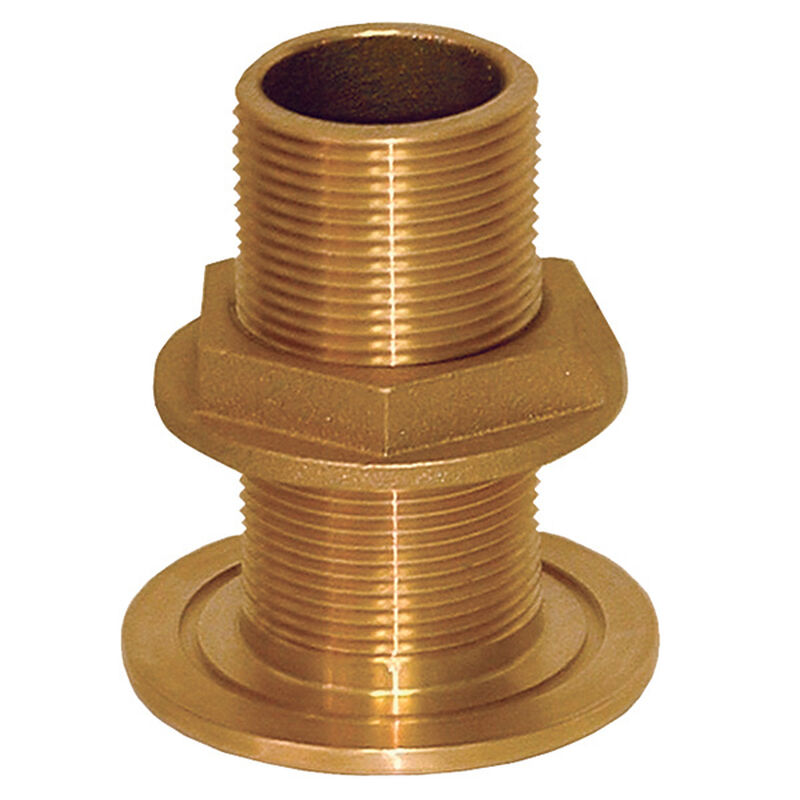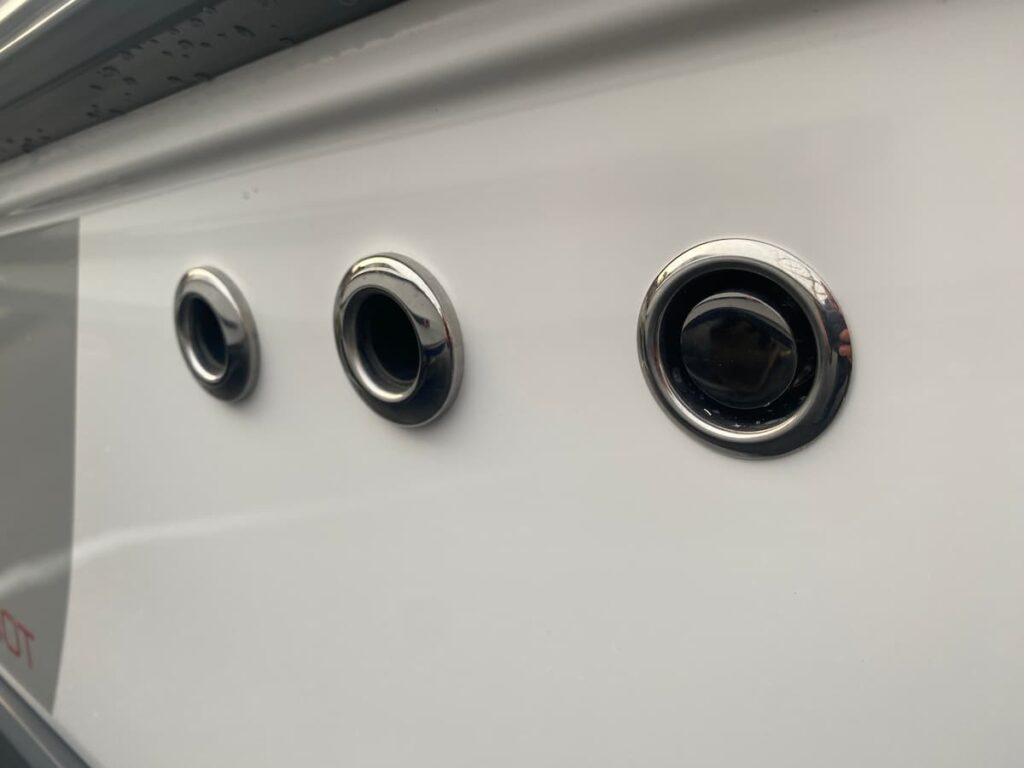Thru-hull fittings are an essential component of any boat, allowing water to enter and exit the vessel. These fittings are typically made of bronze or plastic and are designed to be installed through the hull of the boat. They come in a variety of shapes and sizes, depending on the specific application and the size of the boat.
Thru-hull fittings can be used for a range of purposes, including providing water to the boat’s plumbing system, draining water from the bilge, and allowing water to enter the cooling system for the engine.
It is important to choose the right type of fitting for each application, as using the wrong type can lead to leaks, corrosion, and other problems. In addition, it is important to ensure that the fittings are installed correctly, with the correct sealant and backing plate, to prevent water from entering the boat through the fitting.

Types of Thru-Hull Fittings
Thru-hull fittings are an essential component of any boat’s plumbing system, and they come in different materials and designs. In this section, we will discuss the three main types of thru-hull fittings: plastic, bronze, and composite.
Plastic Thru-Hull Fittings
Plastic thru-hull fittings are a popular choice for boaters due to their affordability and ease of installation. They are typically made from high-strength plastic materials such as PVC or ABS and are resistant to corrosion.
However, plastic thru-hull fittings are not as durable as their metal counterparts and may not be suitable for boats that frequently travel in rough waters.
Bronze Thru-Hull Fittings
Bronze thru-hull fittings are a traditional choice for boaters due to their strength and durability. They are typically made from a combination of copper and zinc and are resistant to corrosion.
Bronze thru-hull fittings are suitable for boats that frequently travel in rough waters and are often used in saltwater environments. However, they are more expensive than plastic fittings and require more maintenance.

Composite Thru-Hull Fittings
Composite thru-hull fittings are a relatively new addition to the market and are made from a combination of materials such as fiberglass and resin. They are lightweight, strong, and resistant to corrosion, making them an excellent choice for boats that frequently travel in rough waters.
Composite thru-hull fittings are also easy to install and require little maintenance. However, they are more expensive than plastic fittings and may not be as durable as bronze fittings.

What Is The Best Material For Thru-Hull Fittings?
The best material for thru-hull fittings depends on the boat’s intended use and the owner’s personal preferences. Plastic fittings are suitable for boats that operate in calm waters and are on a budget, while bronze fittings are a traditional choice for boats that frequently travel in rough waters. Composite fittings are a newer option that offers a balance between strength, durability, and affordability. Ultimately, the choice of material should be based on the boat’s intended use, the environment it will operate in, and the owner’s budget.
In summary, there are three main types of thru-hull fittings: plastic, bronze, and composite. Each material has its advantages and disadvantages, and the best option depends on the boat’s intended use and the owner’s personal preferences.
Key Brands and Manufacturers
When it comes to thru-hull fittings for boats, there are a number of key brands and manufacturers that are worth considering. Here are some of the top options:
Groco
Groco is a leading manufacturer of marine hardware and plumbing systems, including thru-hull fittings. They offer a wide range of options to suit different needs and budgets, from basic bronze fittings to high-end stainless steel models. Groco is known for their high-quality construction and attention to detail, making them a popular choice among boaters.
T-H Marine
T-H Marine is another well-known brand in the marine industry, offering a variety of thru-hull fittings and other boating accessories. Their fittings are made from durable materials like nylon and stainless steel, and are designed to withstand the harsh marine environment. T-H Marine is also known for their innovative products, such as their SnapFlex LED lights that can be installed directly into thru-hull fittings.
Perko
Perko has been producing marine hardware and accessories for over 100 years, and their thru-hull fittings are a popular choice among boaters. They offer a range of options in different materials and sizes, including bronze, stainless steel, and plastic. Perko’s fittings are known for their durability and corrosion resistance, making them a good choice for saltwater environments.
Southco
Southco is a global manufacturer of engineered access solutions, including a range of thru-hull fittings for boats. Their fittings are designed to be easy to install and maintain, with features like snap-on covers and quick-release mechanisms. Southco’s fittings are also available in a range of materials, including stainless steel, plastic, and brass.
Attwood
Attwood is a leading manufacturer of marine hardware and accessories, including thru-hull fittings. They offer a range of options in different materials and sizes, from basic plastic fittings to high-end stainless steel models. Attwood’s fittings are designed to be easy to install and maintain, and are known for their reliability and durability.
Overall, these key brands and manufacturers offer a range of options for boaters looking for high-quality thru-hull fittings. Whether you’re looking for basic plastic fittings or high-end stainless steel models, there’s a brand and model that can meet your needs and budget.
Installation and Positioning
Thru-hull fittings are an essential component of any boat’s plumbing system. Proper installation and positioning of these fittings are crucial for the safety and performance of the vessel. In this section, we will discuss the installation and positioning of thru-hull fittings, including above and below the waterline.
Above the Waterline
Thru-hull fittings installed above the waterline are typically used for ventilation, water intake, or discharge. These fittings should be installed in a location that is easily accessible and visible. The installation should be done in such a way that the fitting is securely fastened to the hull and sealed with an appropriate sealant.
Below the Waterline
Thru-hull fittings installed below the waterline are used for various purposes, including water intake, discharge, and bilge pump outlets. The installation of these fittings requires extra care and attention to ensure that they are properly positioned and sealed. It is essential to choose the correct size and type of fitting for the specific application.
When installing below the waterline, it is important to consider the type of hull material and the thickness of the hull. The fitting should be installed in a location that is easily accessible for maintenance and inspection. It is also recommended to install a seacock valve between the thru-hull fitting and the hose to allow for easy maintenance and to prevent water from entering the boat in case of a failure.
BSP, NPS, NPT, and Pipe
Thru-hull fittings come in different sizes and types, including BSP (British Standard Pipe), NPS (National Pipe Straight), NPT (National Pipe Taper), and pipe. It is essential to choose the correct type and size of fitting to ensure a secure and leak-free installation. The size of the fitting should match the size of the hose or pipe that it is connected to.
Conclusion
Proper installation and positioning of thru-hull fittings are crucial for the safety and performance of a boat. Above the waterline fittings should be installed in a visible and accessible location, while below the waterline fittings require extra care and attention to ensure a secure and leak-free installation. Choosing the correct size and type of fitting is essential for a successful installation.
Understanding Seacocks
A seacock is a type of valve that controls the flow of water into and out of a boat. It is an essential part of any boat’s plumbing system and is used to prevent water from entering the boat through the hull. Seacocks are typically made of bronze or other high-quality materials that are resistant to corrosion and can withstand the harsh marine environment.
Seacocks are designed to be easily accessible and operable in case of an emergency. They should be inspected regularly to ensure that they are functioning properly and are not damaged or corroded. If a seacock is found to be damaged or disabled, it should be replaced immediately to prevent water from entering the boat and causing damage.
It is important to choose a high-quality seacock that is appropriate for the size and type of boat. A seacock that is too small or weak may fail under pressure, while a seacock that is too large may be difficult to operate and may not provide adequate protection against water intrusion.
When selecting a seacock, it is important to consider the following factors:
- Size: The size of the seacock should be appropriate for the size of the boat and the amount of water that needs to be controlled.
- Material: The seacock should be made of high-quality materials that are resistant to corrosion and can withstand the marine environment.
- Accessibility: The seacock should be easily accessible and operable in case of an emergency.
- Durability: The seacock should be durable and able to withstand the harsh marine environment.
Overall, understanding seacocks is essential for any boat owner. By choosing a high-quality seacock and inspecting it regularly, boat owners can ensure that their boats are protected from water intrusion and other potential hazards.
Thru-Hull Fittings and Drains
Thru-hull fittings are an essential component of any boat’s plumbing system. They are used to connect hoses to the boat’s water supply, as well as to drain water out of the boat. Thru-hull fittings can be made of various materials, including plastic, bronze, and stainless steel. It is important to choose the right material for the fitting based on the type of water it will be exposed to and the environment it will be in.
Sink Drains
Sink drains are a common type of thru-hull fitting found on boats. They are used to drain water from sinks and other fixtures on the boat. Sink drains are typically made of plastic or bronze and come in various sizes to fit different sink openings.
When installing sink drains, it is important to ensure that they are properly sealed to prevent leaks. This can be done using a sealant such as marine-grade silicone or by using a rubber gasket. It is also important to ensure that the drain hose is properly connected to the fitting and that it is secured in place to prevent it from coming loose.
Regular maintenance is important to ensure that sink drains and other thru-hull fittings are functioning properly. This includes checking for leaks, inspecting the hoses for cracks or damage, and ensuring that the fittings are securely fastened.
In summary, thru-hull fittings and drains are an essential component of any boat’s plumbing system. When choosing fittings, it is important to consider the type of water they will be exposed to and the environment they will be in. Sink drains are a common type of thru-hull fitting and should be properly installed and maintained to prevent leaks and ensure proper functioning.
Thru-Hull Connectors
Thru-hull connectors are an essential component of any boat’s plumbing system. They are used to connect various types of hoses and ducts to the hull of the boat, allowing water to flow in and out of the vessel. Thru-hull connectors are available in a variety of materials, including bronze, stainless steel, and plastic.
When selecting a thru-hull connector, it is important to consider the material and size of the connector, as well as the type of hose or duct that will be connected to it. Bronze and stainless steel are the most durable materials, while plastic connectors are more affordable and lightweight.
It is also important to ensure that the connector is properly installed and secured to the hull of the boat. Improper installation can lead to leaks and other issues that can compromise the safety of the vessel.
Thru-hull connectors are available in a variety of sizes and shapes, including straight, angled, and elbow connectors. It is important to select the correct connector for the job to ensure proper water flow and prevent leaks.
Overall, thru-hull connectors are an important component of any boat’s plumbing system. It is important to select the right connector for the job and ensure that it is properly installed and secured to the hull of the vessel.
Safety and Standards
Boat owners must prioritize safety when it comes to thru-hull fittings. These fittings are responsible for allowing water to enter and exit the boat, and if they fail, it can lead to catastrophic consequences. Therefore, it’s essential to adhere to safety and standards set by regulatory bodies like the American Boat and Yacht Council (ABYC).
The ABYC has established a set of standards for thru-hull fittings, which cover everything from installation to strength requirements. These standards are designed to ensure the safety of boat owners and passengers. They cover different types of fittings, such as seacocks, ball valves, and gate valves, and provide guidelines for their installation and maintenance.
When installing thru-hull fittings, it’s essential to follow the ABYC standards to reduce the risk of failure. The standards specify the minimum strength requirements for fittings, and it’s essential to choose fittings that meet or exceed these requirements. It’s also crucial to ensure that the fittings are installed correctly and that they are inspected regularly to ensure that they are in good working condition.
In addition to the ABYC standards, boat owners must also consider the risk associated with thru-hull fittings. For example, fittings located below the waterline are at a higher risk of failure due to increased pressure and exposure to the elements. Therefore, it’s essential to choose high-quality fittings that are designed to withstand these conditions.
Overall, boat owners must prioritize safety when it comes to thru-hull fittings. By following the ABYC standards and considering the risk associated with these fittings, boat owners can reduce the risk of failure and ensure the safety of everyone on board.
Frequently Asked Questions
What is the best material for thru hull fittings?
The best material for thru hull fittings is bronze. It is a strong and durable material that can withstand the harsh marine environment. Stainless steel is also a good option, but it is more prone to corrosion than bronze.
Can plastic materials be used for thru hull fittings?
Plastic materials can be used for thru-hull fittings, but they are not recommended for below the waterline applications. Plastic fittings are more prone to cracking and can fail under pressure.
When should I replace my thru hull fitting?
Thru hull fittings should be replaced if they show signs of wear and tear, such as cracks or corrosion, or if they are more than 10 years old. It is important to regularly inspect your thru-hull fittings to ensure they are in good condition.
What are the different types of thru hull fittings?
There are several types of thru hull fittings, including straight fittings, elbow fittings, and flush fittings. Straight fittings are used for through-hull installations that are perpendicular to the hull. Elbow fittings are used for through-hull installations that require a 90-degree bend. Flush fittings are used for through-hull installations that require a flush mount.
How do I properly install a thru-hull fitting?
To properly install a thru-hull fitting, you should first select the appropriate fitting for your application. Then, you should drill a hole through the hull at the desired location and install the fitting using marine sealant. It is important to ensure that the fitting is properly aligned and tightened to prevent leaks.
What is the purpose of a thru-hull valve?
A thru-hull valve is used to control the flow of water through a thru-hull fitting. It allows you to open or close the fitting as needed to prevent water from entering the boat or to allow water to exit the boat. It is important to ensure that the valve is in good condition and operates smoothly to prevent any issues while on the water.
- Types of Gas Carriers as per IGC Code – April 22, 2025
- Wind-Assisted Propulsion Systems (WAPS): A Game Changer for Maritime Decarbonization – February 6, 2025
- 10 Boat Salvage Yards in California – January 25, 2025



